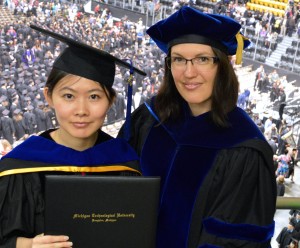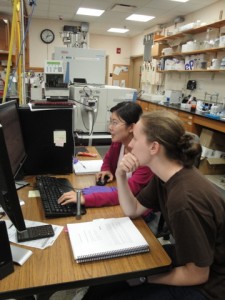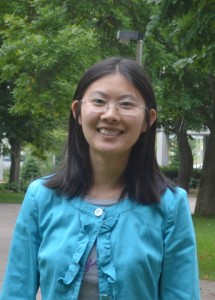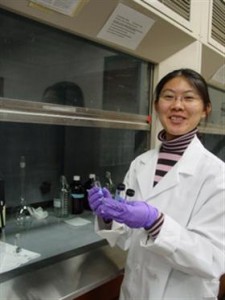Congratulations, Dr. Yunzhu Zhao!
Dr. Yunzhu Zhao
2014 Ph.D. Environmental Engineering
Molecular Characterization of Atmospheric Organic Matter in Biogenic Secondary Organic Aerosol, Ambient aerosol and Clouds
Dissertation Abstract: Atmospheric aerosol affects the Earth’s energy budget, reduces visibility and influences human health. The organic composition of aerosol is quite complex and continuously evolves through various atmospheric processes. To gain a deeper understanding of the molecular composition of atmospheric organic matter (AOM), chamber-generated biogenic secondary organic aerosol (SOA), ambient aerosol and cloud water samples were studied. Ultrahigh resolution Fourier Transform Ion Cyclotron Resonance Mass Spectrometry was used to provide detailed molecular characterization of the atmospheric samples. Due to the extremely high mass resolution and mass accuracy, thousands of individual molecular formulas were identified in all of the samples studied. Multivariate statistical analysis methods were evaluated to compare the similarities and differences of the sample compositions. The biogenic SOA from three individual monoterpene precursors and a sesquiterpene precursor have clusters of peaks in their mass spectra, indicating that high molecular weight oligomers are a major component of the SOA. The monoterpene SOA have similar molecular compositions, which are different from the sesquiterpene SOA composition. The indicator species of SOA were identified using multivariate statistical analysis. Daily 24-hour water-soluble organic carbon samples from ambient aerosol collected at the Storm Peak Laboratory (SPL) show similar bulk chemical properties regarding their average elemental ratios and double bond equivalents. Using multivariate statistical analysis, the site meteorological conditions were found to affect the aerosol molecular composition. Days with strong UV radiation and high temperature were found to contain large numbers of biogenic SOA molecular formulas. Days with high relative humidity and high sulfate ion concentrations were found to contain many sulfur-containing compounds, suggesting their aqueous phase formation. The collection of cloud samples at the SPL provided an opportunity to study aqueous processing of AOM. The cloud composition was affected by biomass burning and SOA. Comparisons of the sample compositions indicate biogenic SOA components are commonly observed in ambient aerosol and cloud samples collected at the SPL. Thus, the ambient samples were used to confirm the biogenic SOA indicator species identified in chamber-generated SOA. This study of the three types of atmospheric samples helps to understand the composition of AOM with respect to atmospheric processes.
Representative Publications:
Zhao, Y., A.G. Hallar, and L.R. Mazzoleni, Atmospheric Organic Matter in Clouds: Exact Masses and Molecular Formula Identification using Ultrahigh Resolution FT-ICR Mass Spectrometry, Atmospheric Chemistry and Physics, 13, 12343-12362, 2013.
Zhao, Y., M.M. Dalbec, R. Fisseha, A.L. Putman, S. Kundu, T.A. Rahn and L.R. Mazzoleni, Comprehensive Biogenic Secondary Organic Aerosol Characterization and Identification of Specific Indicator Molecular Formulas, Atmospheric Chemistry and Physics, In Preparation, 2015.
A few fun photos:






